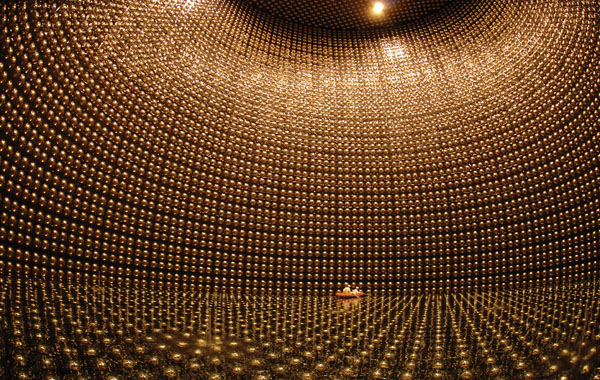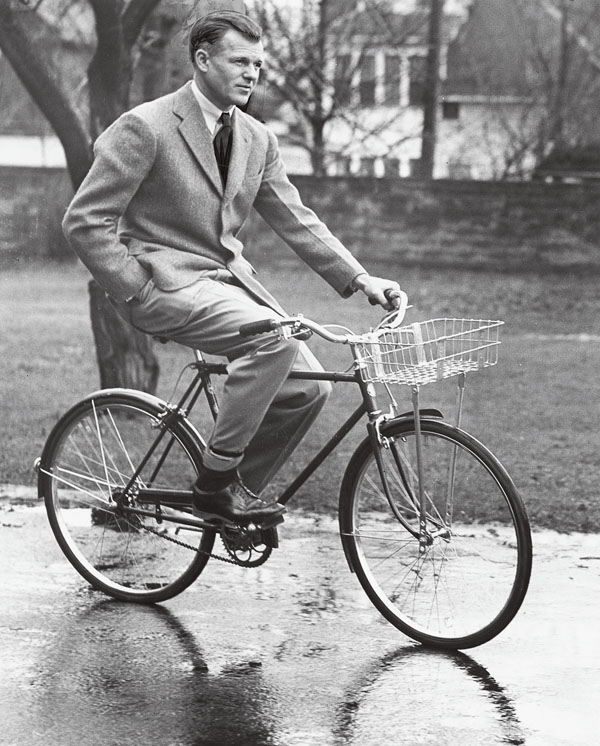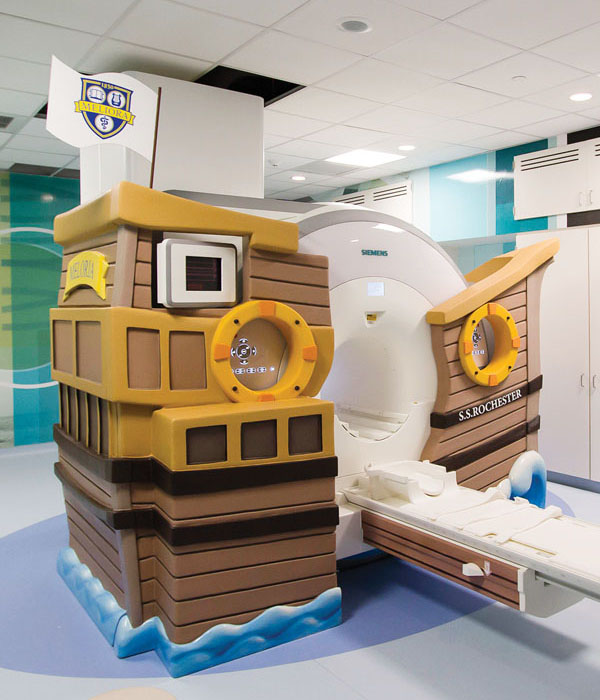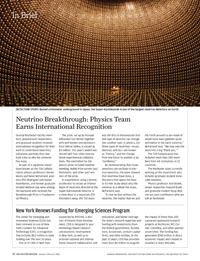In Review
 DETECTION STORY: Buried a kilometer underground in Japan, the Super-Kamiokande is one of the largest neutrino detectors on
Earth. (Photo: Kamioka Observatory, ICRR (Institute for Cosmic Ray Research), The University of Tokyo)
DETECTION STORY: Buried a kilometer underground in Japan, the Super-Kamiokande is one of the largest neutrino detectors on
Earth. (Photo: Kamioka Observatory, ICRR (Institute for Cosmic Ray Research), The University of Tokyo)Several Rochester faculty members, postdoctoral researchers, and graduate students received international recognition for their work to understand neutrinos, subatomic particles that may hold a key to why the universe has mass.
As part of a Japanese-based team known as the T2K Collaboration, physics professors Steven Manly and Kevin McFarland, postdocs Phil Rodrigues and Daniel Ruterbories, and former graduate student Melanie Day were among the laureates who received the Breakthrough Prize in Fundamental Physics.
The prize, set up by Russian billionaire Yuri Milner together with well-known entrepreneurs from Silicon Valley, is valued at $3 million. This year’s award was shared with four other international experimental collaborations. The committee for the physics prize included Stephen Hawking, Nobel Prize winner Saul Perlmutter, and other past winners of the prize.
In experiments using a proton accelerator to create an intense beam of neutrinos directed at the Super-Kamiokande detector in a mine deep in a mountain 295 kilometers away, the T2K team was the first to demonstrate that one type of neutrino can change into another type. In physics, the three types of neutrinos—muon, electron, and tau—are known as “flavors,” and the change from one flavor to another is an “oscillation.”
By demonstrating that muon neutrinos can oscillate to electron neutrinos, the team showed that neutrinos have mass, a discovery that opens the door to further study about why the universe as a whole has mass, McFarland says.
“It may be that without the neutrino, the matter that we and the Earth around us are made of would have been gobbled up by antimatter in the early universe,” McFarland says. “We may owe the neutrinos a big ‘thank you.’ ”
The T2K Collaboration has included more than 500 members from 64 institutions in 12 countries.
The Rochester team currently working on the experiment also includes graduate student Konosuke Iwamoto.
Physics professor Arie Bodek, senior researcher Howard Budd, and graduate student Hyup Woo Lee are past contributors who are still at Rochester.
New York Renews Funding for Emerging Sciences Program
The Center for Emerging and Innovative Sciences (CEIS) has been renewed as one of New York’s Centers for Advanced Technology (CAT), a recognition that includes $9.2 million in state funding over the next 10 years.
One of 15 CATs in New York supported by NYSTAR, a division of Empire State Development, CEIS is designed to spur technology-based research and economic development in New York, as well as to promote national and international research collaboration and innovation, and better leverage the state’s research expertise and funding with investments from the federal government, foundations, businesses, venture capital firms, and other entities. In the past 10 years, CEIS has provided more than $4 million to magnify the impact of more than 200 corporate-sponsored research projects at Rochester, RIT, Cornell, Columbia, and other partner universities. The funding has generated $740 million in direct economic impact and created or retained at least 440 jobs.
University Joins Pulmonary Fibrosis Care Network
The Medical Center has been selected to join a national network dedicated to treating and researching pulmonary fibrosis, a respiratory disease that affects about 200,000 Americans a year.
UR Medicine’s Pulmonary Division was selected to be part of the Pulmonary Fibrosis Foundation Care Center Network, a multidisciplinary effort designed to provide patient care through teams of experts in pulmonary medicine, rheumatology, radiology, and pathology. The network includes 40 medical centers in 26 states.
Also known as lung scarring, pulmonary fibrosis can severely reduce the ability of the lungs to transfer oxygen into the bloodstream, causing shortness of breath.
While many forms have specific causes and are treatable, a common form, idiopathic pulmonary fibrosis, is difficult to treat and has no cure.
Rochester: Bicycle Friendly
 BIG WHEELS: President Alan Valentine cycling in 1942 (Photo: University Libraries/Department of Rare Books, Special Collections, and Preservation)
BIG WHEELS: President Alan Valentine cycling in 1942 (Photo: University Libraries/Department of Rare Books, Special Collections, and Preservation)A national program to promote and encourage bicycling on college and university campuses has recognized Rochester.
The University received a Bronze Award from the League of American Bicyclists as part of the organization’s Bicycle Friendly University program. The effort recognizes institutions of higher education for promoting and providing a more bikeable campus for students, staff, and visitors. Applicants are evaluated on efforts to promote bicycling in five areas: engineering, encouragement, education, enforcement, and evaluation and planning. Rochester was one of 49 new and renewing campuses recognized this year, according to the organization, which has identified 127 bicycle-friendly universities in 42 states.
Golisano Children’s Hospital Debuts Dual Imaging System
 S. S. ROCHESTER: Golisano Children’s Hospital became the first children’s hospital in the country to take medical images with technology that combines two imaging processes into one device. (Photo: Medical Center)
S. S. ROCHESTER: Golisano Children’s Hospital became the first children’s hospital in the country to take medical images with technology that combines two imaging processes into one device. (Photo: Medical Center)Golisano Children’s Hospital has became the first children’s hospital in the country to use a new medical imaging approach designed to reduce radiation exposure while allowing for two different types of measurement to be taken at the same time.
The hospital, which officially opened last July, administered the first scan with an integrated PET-MRI this fall. The scanner combines two common imaging procedures—positron emission tomography and magnetic resonance imaging—into one device.
The combination allows young patients to undergo only one treatment. At the same time, the device provides clinicians with precise information about metabolic functions as well as three-dimensional images about particular areas of a patient’s body.
Labeled the “S. S. Rochester” and decorated to look like a pirate ship, the device is designed to be welcoming and child-friendly. It’s housed in an imaging suite that also features a computerized tomography scanner decorated to resemble a lighthouse.
Regional Hospitals Join UR Medicine
UR Medicine, the University’s network of clinical health care affiliates, now includes five hospitals. That’s after Jones Memorial Hospital in Wellsville and Noyes Health in Dansville officially joined the network.
Approved by each organization’s board, the affiliation agreements were announced at ceremonies at each hospital this fall.
The move expands UR Medicine’s network to five hospitals, including Strong Memorial and Highland Hospitals, both in Rochester, and Thompson Health in Canandaigua.
The addition of the new hospitals is part of a regional effort to strengthen health care services for patients across the Southern Tier of New York.

